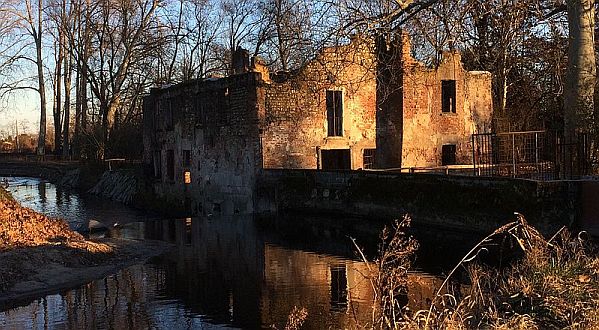Description

The fascination of the ruins and the nature
Located on a naturalistic island formed by two acequias dipartin from the Olona, the already ruin mill under the castle shere the origins (XI-XIII cen.) e the history with the close Visconti's, of which it constituted an attachment. Trasformed in the centuries, it kept its three-wheeled grainmill function until half of twentieth century, resisting as last surviving in Legnano.
The current ruin under the castle (called Mulino Cornaggia, Mulino Lombardo, Mulino Tenconi) springs up on an islet formed by the mill's acequia departing from the Olona and a secondary acequia for the maintenance of the blades. The area, reachable from a brick bridge, was linked to the isle of the castle from another bridge that doesn't exist anymore. The mill, used for the floor production, was linked to the castle since the origins, set to protect the agricultural lands of the territory, of which it followed the sequence of events and the transfer of ownership. The first documents date back to the XIII century and the first appearance on the map in 1606. Managed by Molinari, in the '800s it passed to Cornaggia's ownership, while the castle was turned into a farm. Because of it, contrary to the other mills of Legnano, trasformed in the early ‘900s in factories later wrecked, it kept the activity until the '60s of twentieth century, to be then abandoned and purchased in the ’80s by Legnano. Originally realized in wood and composed by 4 rooms downstairs and 2 upstairs, from 1829 to 1835 it was expanded. In 1850 the wooden part was remade in bricks. The house of the mill's manager dates back tol the same period, whilst the stable and the hayloft behind dates to the early ‘900s. In 1606 it had “4 rodigni” and since ‘700s it was provided with three hydraulic wooden wheels, of which one was substituted by an iron mechanism with a 4m diametre, that permitted the shaft to move the internal millstones. Tracks of the wheels and the machineries are today visible in the circular holes of the external rock walls against the acequia, where a 600's carved date is readable,and inside in the pierced granite blocks that previously hosted the mechanisms. Some grindstones and other items are instead exposed next to the ruins. Today, even if reduced to ruins, the mill keeps a strong symbolic and historical-architectonic value, as a witness of the rural local architecture, at the boundaries of the Mill's PLIS, of which it constitutes the natural continuation and expansion. Recently redeveloped and cleaned, the isle by which it's hosted shows a great naturalistic and environmental appeal, since it hosts autochthonous vegetation (elms, willows, alders, elders etc.), whereas in the bights of the acequia surrounding it there are the ideal conditions for the settlement of amphibia and fishes, also due to the recent creation of a vacuole and anche alla recente realizzazione di un vacuolo and bank works that improved its sinuosity.
Deepening
Video
|
Audio |
E-Book |
Photo |
Other Links |


